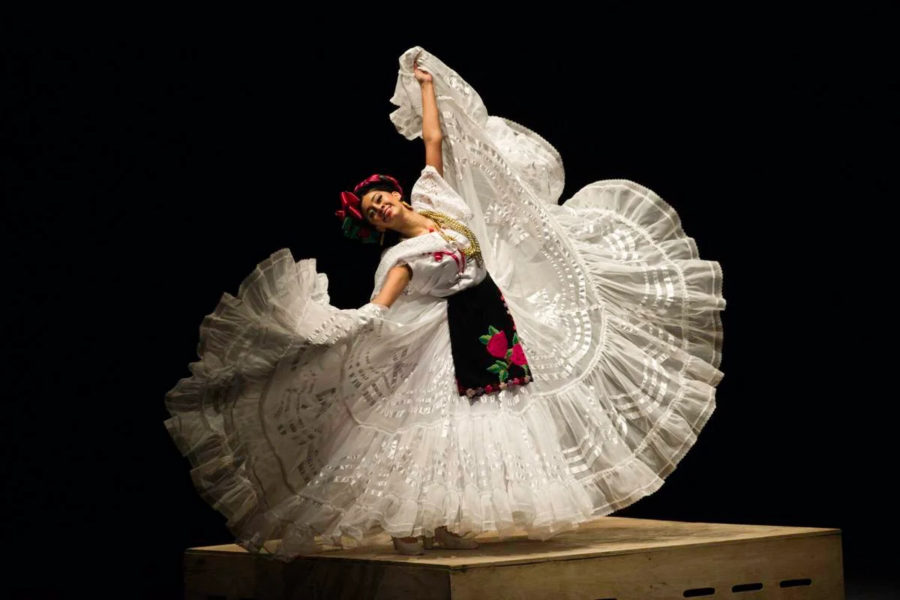From a young age, choreographer Amalia Hernández knew she was going to be a dancer. However, the classical training at Mexico’s National School of Dance didn’t feel right. There was no emotion, no spirit, no heart. So, Hernández instead began her exploration of traditional Mexican dance, learning about native dances from regions all around the country. Out of this experience, Ballet Folklórico de México was born.
Radiating the stories of Mexico’s past and the artistry of visions rooted in tradition, the Ballet Folklórico de México company traveled to the Auditorium Theatre in Chicago in February while on their USA 2022 World Tour. Led by Company Director Salvador López, Ballet Folklórico de México showcased several pieces, all with different elements of Mexican culture and history.
The first ballet, “Aztecas,” translated historical chronicles, sculptures, and artifacts of Aztec ritual dances into choreography. The curtain opened with a blast of bold music and an explosion of colorful costumes dotting the stage. Large headpieces and fans accompanied the dancers’ every step, enlarging their movement and adding energy to the stage. Bells hung from the dancers’ ankles, complimenting the music and accentuating each motion, no matter how small. “Aztecas” was made up of four dances: the “Dance of the Priests,” “Dance of the Maidens,” “Dance of War,” and “Dance of Celebration.” Each was marked with its own instruments, costumes, and choreography, creating a beautiful representation of Aztec culture.
The next piece, “Sones Antiguos de Michoacán,” combined techniques of modern and classical dance, with dancers utilizing their long skirts as part of the performance. These unique visuals drew the audience even further into the performance, capturing their attention into the next performance.
In the “Tarima de Tixtla,” the dancers donned tap shoes, their accented steps shaking the wooden stage and representing the warmth of Guerrero’s people. As the program describes, “the swirl of the skirts and the tapping of the dancers’ feet show an incessant dialogue through dance.” And this feat did indeed get the audience involved in the performance, a trend that continued throughout the rest of the show. The setup of the stage and the placement of the dancers had a community-feel, one in which the audience was included. Those watching showcased a range of reactions, from clapping to the beat of the tap shoes to dancing along with those on the stage.
Next, “La Revolución” painted a picture of “solderas,” or “Adelitas,” preparing for war. Historically, these women had a huge role in the Mexican Revolution that required them to take “their lives and few belongings to the war scenes” (Ballet Folklórico de México Program). The tableau and placement of dancers was displayed to create contrast—aristocrats enjoying an elaborate celebration before the rebels break into the party, prepared to fight. The dance, together with the art, perfectly captured the spirit of the Revolution.
“La Charreada,” the next dance in the performance, incorporated cultural hallmarks from the equestrian and livestock communities of Mexico. The program describes “charrería [as] an art and discipline in which men and women compete, wearing colorful Mexican costumes trimmed in silver studs.” Equestrian elements and props such as the lasso added to wonderful partner dances which featured pairs jumping and moving through the ropes together.
The flamenco-reminiscent choreography in “Fiesta en Tlacotalpan,” imitated the celebration of the Virgen de la Candelaria, during which streets are filled with “mojigangas, fandango dancers, jaraneros, and beautiful women who wear the typical Veracruz costume” (Ballet Folklórico de México Program). A mariachi band accompanied the music being played, adding a theatrical element to the performance, while the dancing in this number, which was particularly lively, drew ecstatic yells from the audience.
“La Vida es un Juego” told a more linear story than the pieces before it, featuring a bride, her groom, her lover, and the devil orchestrating the entire tale. The dance served as a way to connect characters and display their emotions through motion and a rather turbulent plot.
By contrast, “Danza Del Venado” took an artistic approach to depict the Deer Dance, a ritual performed before hunting expeditions in the state of Sonora, in which participants mimic the movements of the prey. The changing movements within this dance created tension as a deer was hunted across the stage. When the deer was finally shot, its death was dramatized by the choreographic portrayal of slowing heartbeats.
The final performance of the ballet, “Fiesta en Jalisco,” began, with the return of the mariachi band. The culture of the Mexican state of Jalisco was shown through vigorous dancing, multicolored costumes, and booming music. This last performance was incredibly special to the audience; the clapping of hands and stomping of feet made the ground shake incessantly, while the loud shouts and exclamations filled the air. At the end of the show, looking around in my seat, I can say with confidence that I had never seen a more unanimous standing ovation.
Although the performance did have some technical mistakes, whether they be a small misstep or a snafu with a lasso, the energy that the cast members brought to the Auditorium Theatre made the show memorable nonetheless. Ballet Folklórico de México’s performance accomplished what the crowd was looking for: a triumphant unification of community and culture.
I highly recommend attending a Ballet Folklórico de México performance in the future. In the meantime, while you wait for their next tour to stop at Chicago, I recommend that you explore similar events through the Chicago Latin Network. I will absolutely be taking advantage of their next opportunity to connect with the performers the way the audience did that night.









